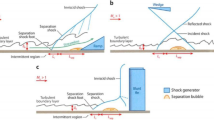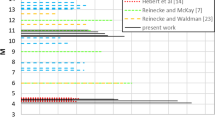Abstract
An experimental demonstration was carried out in a ballistic range at high Mach numbers with the low specific heat ratio gas hydrofluorocarbon HFC-134a to observe the unstable bow-shock wave generated in front of supersonic blunt objects. The shadowgraph images obtained from the experiments showed instability characteristics, in which the disturbances grow and flow downstream and the wake flow appears wavy because of the shock oscillation. Moreover, the influence of the body shape and specific heat ratio on the instability was investigated for various experimental conditions. Furthermore, the observed features, such as wave structure and disturbance amplitude, were captured by numerical simulations, and it was demonstrated that computational fluid dynamics could effectively simulate the physical instability. In addition, it was deduced that the shock instability is induced by sound emissions from the edge of the object. This inference supports the dependence of the instability on the specific heat ratio and Mach number because the shock stand-off distance is affected by these parameters and limits the sound wave propagation.














Similar content being viewed by others
References
Baryshnikov, A.S., Bedin, A.P., Maslennikov, V.G., Mishin, G.I.: Stability of a bow shock. Sov. Tech. Phys. Lett. 5, 113–114 (1979)
Baryshnikov, A.S.: Baroclinic turbulence of dissociating gas as a reason for instability of bow shock wave. Phys. Scr. T132, 014007 (2008)
Sato, Y.: Numerical analysis and experimental demonstration of bow-shock instability. Master’s Thesis, Tohoku University (2013)
Sato, Y., Yasue, K., Ohnishi, N.: Numerical simulation of bow-shock instability around circular cone. In: Proceedings of 20th International Shock Interaction Symposium, pp. 157–160 (2012)
Sato, Y., Suzuki, Y., Yasue, K., Ohnishi, N.: Three-dimensional simulation of bow-shock instability using discontinuous Galerkin method. In: Proceedings of 28th International Symposium on Shock Waves, vol. 2, pp. 1027–1033 (2012)
Ohnishi, N., Sato, Y., Kikuchi, Y., Ohtani, K., Yasue, K.: Bow-shock instability induced by Helmholtz resonator-like feedback in slipstream. Phys. Fluids 27, 066103 (2015)
Quirk, J.J.: A contribution to the great Riemann solver debate. Int. J. Numer. Methods Fluids 18, 555–574 (1994)
Ohmichi,Y., Suzuki,K.: Fundamental study on numericalmethods of global instability analysis for compressible flows with shock wave. In: Proceedings of 43rd Fluid Dynamics Conference, Fluid Dynamics and Co-located Conferences, AIAA 2013-3206 (2013)
Numata, D.: Experimental study on hypervelocity impact phenomena at low temperature with ballistic Range. PhD Thesis, Tohoku University (2008)
Numata, D., Ohtani, K., Anyoji, M., Takayama, K., Sun, M.: Experimental study of hypervelocity impacts at low temperatures. Shock Waves 18, 169–183 (2008)
Shima, E., Kitamura, K.: On new simple low-dissipation scheme of AUSM-family for all speeds. In: Proceedings of 47th Aerospace Sciences Meeting (AIAA) including the New Horizons Forum and Aerospace Exposition. Orlando, FL, United States, AIAA 2009-136 (2009)
Van Leer, B.: Towards the ultimate conservative difference scheme. V. A second-order sequel to Godunov’s method. J. Comput. Phys. 32, 101–136 (1979)
McBride, B.J., Zehe, M.J., Gordon, S.: NASA Glenn coefficients for calculating thermodynamic properties of individual species. NASA Technical Paper-2002-211556 (2002)
Svehla, R.A.: Transport coefficients for the NASA Lewis chemical equilibrium program. NASA Technical Memorandum-4647 (1995)
McBride, B.J., Gordon, S.: Computer program for calculating and fitting thermodynamic functions. NASA Reference Publication-1271 (1992)
Acknowledgments
We would like to acknowledge T. Ogawa and T. Ukai for their assistance in conducting the experiments. The computations were performed on a Silicon Graphics International (SGI) Altix UV1000 at the Advanced Fluid Information Research Center, Institute of Fluid Science, Tohoku University. This work was partially supported by a Grant-in-Aid for Scientific Research under Contract No. (C) 26420099 from the Japan Society for the Promotion of Science.
Author information
Authors and Affiliations
Corresponding author
Additional information
Communicated by A. Podlaskin.
Rights and permissions
About this article
Cite this article
Kikuchi, Y., Ohnishi, N. & Ohtani, K. Experimental demonstration of bow-shock instability and its numerical analysis. Shock Waves 27, 423–430 (2017). https://doi.org/10.1007/s00193-016-0669-5
Received:
Revised:
Accepted:
Published:
Issue Date:
DOI: https://doi.org/10.1007/s00193-016-0669-5




